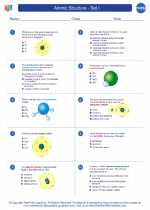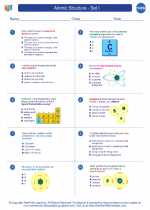Atomic Structure - Set I -> elements
Elements
An element is a substance that is made up of atoms with the same number of protons. Elements are the building blocks of all matter and are organized in the periodic table. Each element has its own unique properties and characteristics.
Atomic Structure
At the center of an atom is a nucleus, which contains protons and neutrons. Surrounding the nucleus are electrons. The number of protons in the nucleus determines the identity of the element, and is known as the atomic number. The total number of protons and neutrons in the nucleus is called the atomic mass.
Periodic Table
The periodic table is a tabular arrangement of the chemical elements, organized by their atomic number, electron configuration, and recurring chemical properties. It is divided into groups (columns) and periods (rows).
Properties of Elements
Elements can be classified as metals, nonmetals, or metalloids based on their physical and chemical properties. Metals are typically good conductors of electricity and heat, whereas nonmetals are poor conductors. Metalloids have properties in between those of metals and nonmetals.
Study Guide
- What is an element?
- Describe the structure of an atom.
- How are elements organized in the periodic table?
- What are the main classifications of elements based on their properties?
- Choose an element from the periodic table and research its properties and uses.
Understanding the concept of elements and their properties is essential for further studies in chemistry. It forms the basis for understanding chemical reactions, bonding, and the behavior of matter at the atomic level.
.◂Chemistry Worksheets and Study Guides High School. Atomic Structure - Set I

 Worksheet/Answer key
Worksheet/Answer key
 Worksheet/Answer key
Worksheet/Answer key
